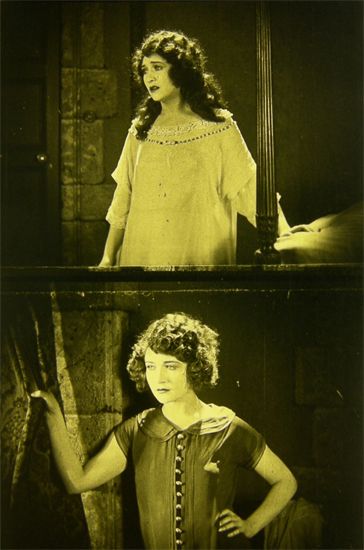Behind the Lost Hitchcock Film
Found in a New Zealand archive, the White Shadow offers a glimpse into early film history that extends beyond the famous director
/https://tf-cmsv2-smithsonianmag-media.s3.amazonaws.com/filer/20110825032014white-shadow-hitchcock-small.jpg)
News of the discovery of The White Shadow, a 1923 film previously considered lost, drew far-ranging attention from the media, with stories appearing everywhere from the Los Angeles Times to the BBC and in between. Most accounts focused on the fact that The White Shadow is Alfred Hitchcock’s earliest surviving credit, but the story behind its resurrection is just as fascinating. The future “Master of Suspense,” 24 at the time, wrote the scenario, edited the film and was also assistant director and art director. The White Shadow was a none-too-successful follow-up to Woman to Woman, which featured much of the same cast and crew, was also written by Hitchcock, and is still considered lost.
Both films were directed by Graham Cutts, considered one of the more reliable British directors of the 1920s and acknowledged by Hitchcock as his mentor. But Cutts does not have the same recognition factor as Hitchcock, which led some writers, notably David Sterritt, author of The Films of Alfred Hitchcock, to dismiss him unfairly as a “hack.” (Luke McKernan offers an amusing opposing view on his Bioscope blog.)

Finding hints of The Lady Vanishes or Psycho in what remains of The White Shadow (three reels, or roughly the first half of the film) may be tough. Many film historians believe that Hitchcock struggled to find a style until the beginning of the sound era. I won’t comment on what The White Shadow adds to the Hitchcock canon until I see the footage. It would sort of be like finding a tape recording of Bob Dylan playing backup in somebody’s band in 1957 and then, without ever actually hearing it, trying to connect it to “Like a Rolling Stone.” But the other names associated with the project — industry veterans who would connect with each other on future films — should be just as interesting to film buffs.
Betty Compson, the star, played two parts, the wholesome Georgina and her less scrupulous twin Nancy. Both Compson and her co-star Clive Brook would later work with director Josef von Sternberg (in The Docks of New York and Shanghai Express, respectively). Michael Balcon, one of the producers, had the same job on Hitchcock’s international hit The 39 Steps (1935). Victor Saville, another producer, had credits that included Jessie Matthews musicals and MGM’s Goodbye, Mr. Chips (1939). The recently discovered film was distributed in the United States by Lewis J. Selznick, whose son David O. Selznick brought Hitchcock to America to direct Rebecca.
That any of The White Shadow exists may be because the film went to New Zealand to die. At the time, exhibitors rented the prints they showed in theaters, and were supposed to return or destroy them when the run was finished. New Zealand was the end of the line in many cases. Some projectionists and collectors found it easier to stash the films and “forget” about them. Many of these subsequently ended up in national archives.
A few years ago, the National Film Preservation Foundation began a project to repatriate American films from archives in Australia and New Zealand. With funding from the Andrew W. Mellon Foundation, nitrate expert Leslie Anne Lewis examined the American holdings in The New Zealand Film Archive. She tied two reels with the “convenience title” of Twin Sisters to a third, unidentified reel. (For films without introductory or closing credits, archivists often supply their own titles for filing purposes.) Frame comparisons, edge code numbering, and US copyright records helped confirm that all three reels were from The White Shadow. As Annette Melville, director of the NFPF, described it, identifying a film can be like filling in a crossword puzzle. Cross-referencing filmographies, theatrical release charts, organizational files and, in this case, copyright records that included a scene-by-scene breakdown of the film all helped Lewis reach her conclusions. The crucial step was examining the footage by hand over a light table.
Melville credits the New Zealand archivists for their generosity and expertise in recovering this and other movies. Credit also goes to a grant from Save America’s Treasures, which helped pay for preservation of some 40 films repatriated from New Zealand in 2010. The award operated as a one-to-one matching grant, which meant that the NFPF needed additional help to secure and preserve the remaining films. And that was before Congress stopped funding for the entire program.
What will happen to the other films in the New Zealand collection? “A lot depends on whether we can get sufficient funding to complete all the films in the cache,” Melville said recently. “We’ve been trying to secure funds through private parties, a number of whom have stepped up to the plate to help. Some of the studios who still own copyrights for the films have been really generous because they felt that the films were so important to their corporate heritage.”
Anyone can contribute, and as Melville points out, “A short film is not terribly expensive comparatively speaking to preserve. Last year some bloggers in the For Love of Film project raised over $11,000 on the web to preserve three of the New Zealand films, including The Sergeant, the first narrative shot in Yosemite, and The Better Man.”
Many of the restored films can be seen on the NFPF website. Melville singles out U.S. Navy of 1915, which has received close to 150,000 views. Only recently identified, this eleven-minute fragment from a longer documentary was made with the cooperation of Secretary of the Navy Josephus Daniels, and features footage of the “E-2″ class submarine in action.
The White Shadow will be shown at The Academy of Motion Picture Arts and Sciences on September 22, prior to screenings at other venues.
Editor’s Note, August 25, 2009: This post was updated to note that Save America’s Treasures did not fund the restoration of The White Shadow.
/https://tf-cmsv2-smithsonianmag-media.s3.amazonaws.com/accounts/headshot/daniel-eagan-240.jpg)
/https://tf-cmsv2-smithsonianmag-media.s3.amazonaws.com/accounts/headshot/daniel-eagan-240.jpg)